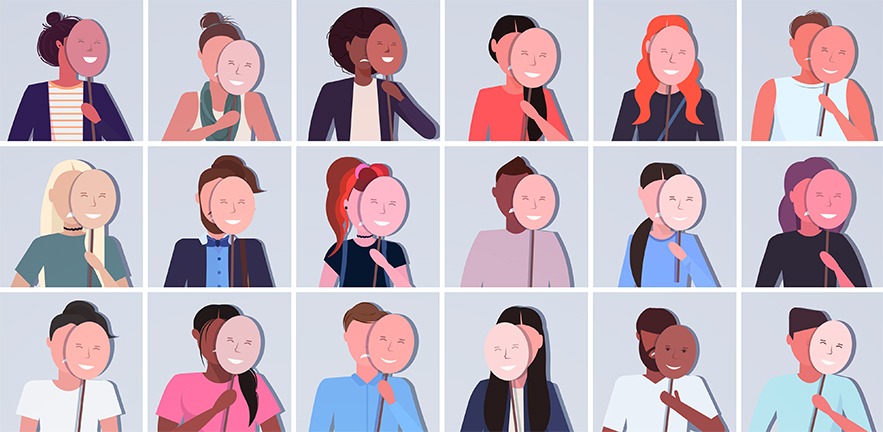Useful Valentine’s Day technology: model that transforms photos into contour images provides useful “facial clues” to make online dating decisions while preserving privacy.

As Valentine’s Day approaches, it’s a reminder that consumers often encounter a “face dilemma” when using online dating services.
While individuals and companies use facial information to make many decisions in their personal and professional lives, the explosion of facial images through online channels such as online dating and social networking sites increases the risk of privacy violations, exploitation, discrimination and other issues.
A study co-authored at Cambridge Judge Business School proposes a novel solution to this dilemma: a new “contour-as-face” (CaF) framework that transforms actual face images into contour images that provide useful “facial cues” for face-based decision-making contexts. The new model allows people to “make judgments and decisions using face contours as a proxy for faces while preserving facial privacy.”
The study published in the Journal of Marketing Research then tested the CaF model in an online dating context with successful results – with people gleaning perceptions about potential partners while preserving both parties’ identities.
“The model conveys the essential information that is useful for people to make inferences that are helpful to them in making decisions as consumers (or online daters) while still preserving privacy, and in particular regarding age and gender, which is very important in preventing discrimination,” says study co-author Shasha Lu, University Lecturer in Marketing at Cambridge Judge Business School.
Past studies into the “facial dilemma” have proposed two main methods for anonymisation in this area: a “physiognomic” approach based on coordinates of key facial features such as eyebrows, nose and mouth; and the “eigenface” approach in which the target face is represented by a linear function compiled from a matrix of facial images. The study points out that both approaches have drawbacks including the difficulty for others to make “reasonably reliable perceptions” from the target face that would be useful to them as decision makers.
Humans mainly use two types of visual cues in face perception – texture cues that reflect variations in intensity and colour on the facial surface, and structural cues based on the contour of a face.
“Evidence has shown that texture cues provide critical information regarding a face’s identity, gender, and age,” the study says, thus the new CaF model removes texture cues from the face while preserving contour-based cues based around five key facial aspects: eyebrows, eyes, nose, mouth, and overall face. Using Fourier transformation (a mathematical tool that transforms a function from the time domain to the frequency domain, similar to the decomposition of a musical chord into the volume and frequencies of its constituent notes), the model converts these contours of facial parts to mathematically precise contour features for statistical or machine learning models.
The CaF model was evaluated against 15 dimensions that, based on prior research, are known to be critical in people’s face-based decision making – including age, gender, emotional state, apparent physical state including health, and social traits such as confidence, attractiveness and intelligence. Based on tests involving more than 900 people, the model was shown to be effective in people making inferences regarding most of these dimensions – although not for the dimensions related to gender and age.
To check whether privacy is protected, the study then asked 138 participants to guess the identity of people represented by the contour images from a face database. Out of a total of 4,089 guesses of which 1,380 were top choices – only 37 of the 1,380 top choices were correct, or a recognition rate of just 2.68%.
“Overall, our analysis provides convincing evidence that it is not easy for a human to guess the identity, age, or gender associated with a contour image,” the study says. “This suggests that contour images can anonymise one’s identity, as well as age and gender, to prevent human recognition/perception, two critical factors associated with potential discrimination in many real-life contexts.”
To study the feasibility of the CaF framework in real-life decision-making, the researchers applied it to an online dating context, and found that many users believed it to be helpful in eliciting dating-related inferences and decisions while preserving privacy.
“Results from the field implementation showed that consumers are willing to accept and use contour images to make real-life decisions and appreciate contour images for their ability to protect privacy while preserving valuable information for perception,” the study says.
The study says that those participants who did not want their dating chances to be influenced by appearance commented “very positively” on the contour-based model.
“Those who normally are considered beautiful/handsome did not want to date people who were simply attracted to their looks, and those who normally are considered less desirable appearance-wise did not want to be eliminated from consideration without having had a chance to show who they truly are. The use of CaF addresses these concerns while still allowing users to make relevant, face-based perceptual inferences.”
The study in the Journal of Marketing Research – entitled “Contour-as-Face (CaF) Framework: A Method to Preserve Privacy and Perception” – is co-authored by Yinghui Zhou of Shenzhen University, Shasha Lu of Cambridge Judge Business School, and Min Ding of Pennsylvania State University.


